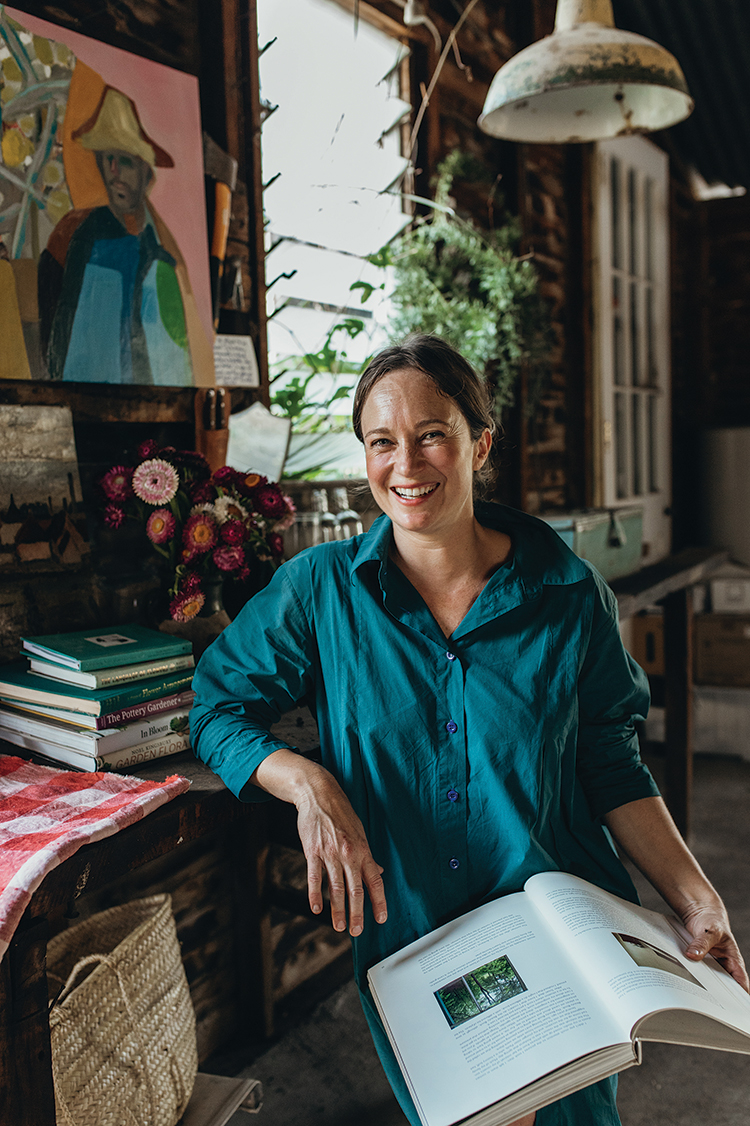
I’m no more a florist than a home cook is a chef. But the great epiphany of my adult life—which took moving to a remote farm 750 km north west of my hometown of Sydney for me to figure out—is that you can actually do a lot of things that you don’t have official qualifications for. Now I spend most of my time suspending giant branches from ceilings and filling sideboards with undulating rivers of wildflowers, but I quite accidentally stumbled into this creative world.
I was a journalist at the national newspaper—a job I adored wholeheartedly, even the door knocks and the other dreadful things you have to do as a low-rung general reporter. I was looking forward to what I hoped would be a long and successful career in journalism in the big smoke. But then I fell in love with a farmer.
The men in the office called him Biggles because he flew a small plane. He picked me up at the airport for our first date, whizzing us to the beaches of Byron Bay. I remember turning to one of the older reporters for advice just before the date, saying “I think I really like this guy, but I am not sure how he feels about me.” The reporter looked at me and said, “He’s picking you up in a goddamn plane and taking you to Byron Bay. He is keen.” Within about six months I had moved to a farm out west. Can you blame me?
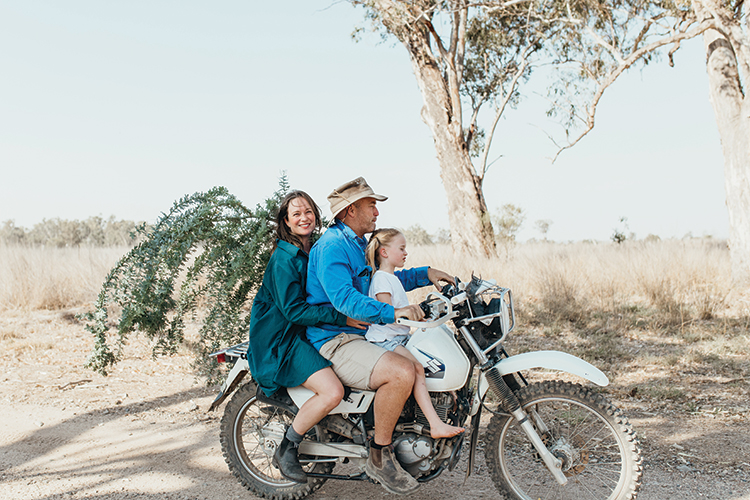
Until I met Ed, I had a track record of being good at working in systems and structures like schools and universities and for other people and companies. I liked to be assigned a project I was qualified to do, to put my head down and to get it done. But the place where I moved with Ed, out in a beautiful valley in the middle of nowhere, had no systems and structures. Or any companies to work for. The closest supermarket was an hour’s drive away. It may as well have been the frontier.
The beautiful arrangements are lovely, but the primary benefit is the way it makes me notice the natural world, the changing of the seasons, the colour of the gum leaves and how they change after rain, the beauty when it’s dry and when it’s green.
I fell into what was a rather uncomfortable slump for several years. I knew I was capable, but could not work out what to do out here. Or rather how to do it without someone assigning deadlines or telling me what needed to be done. I was hopeless on the farm and even worse at doing the farm’s accounting books.
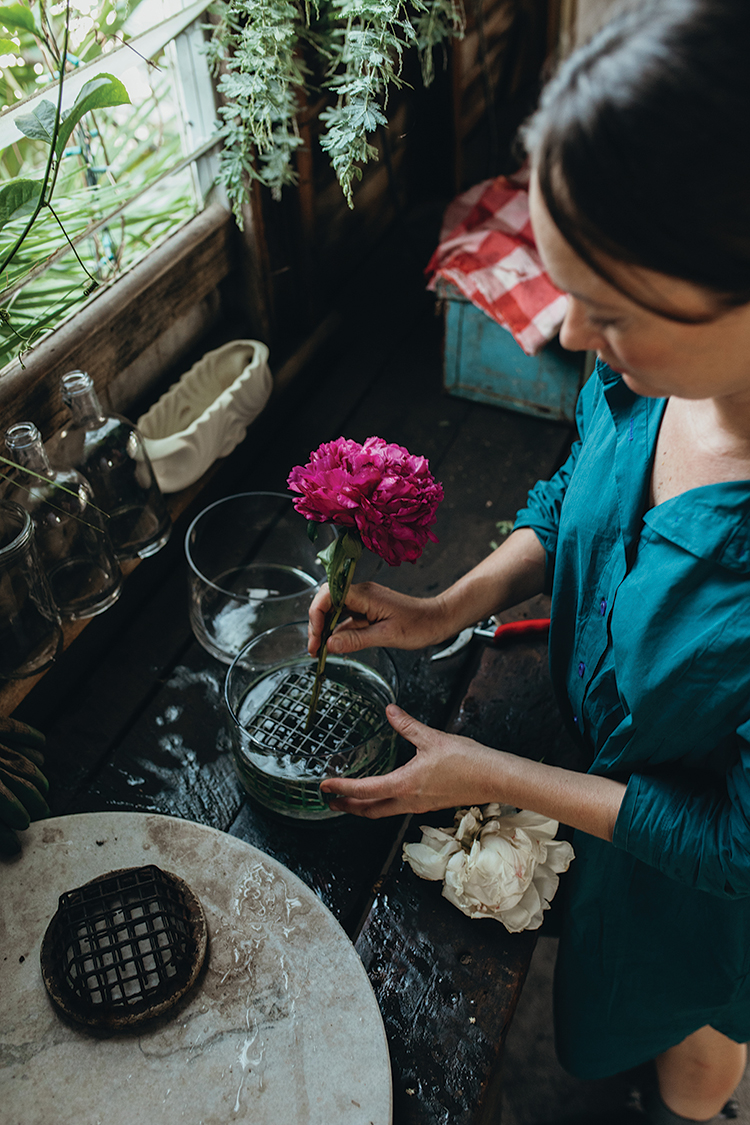
We lived in a charmless little cottage that I could vacuum in its entirety from one power point, but we were ploughing all our money into planting hundreds and hundreds of pecan trees, so other than painting the walls, there was not much I could do on that front.
I realized I had to work out how to be captain of my own ship. I desperately wanted to contribute and create in a way that felt important to me, but I was stuck. And it wasn’t until I started noticing things growing around me that I found a way out of my head.
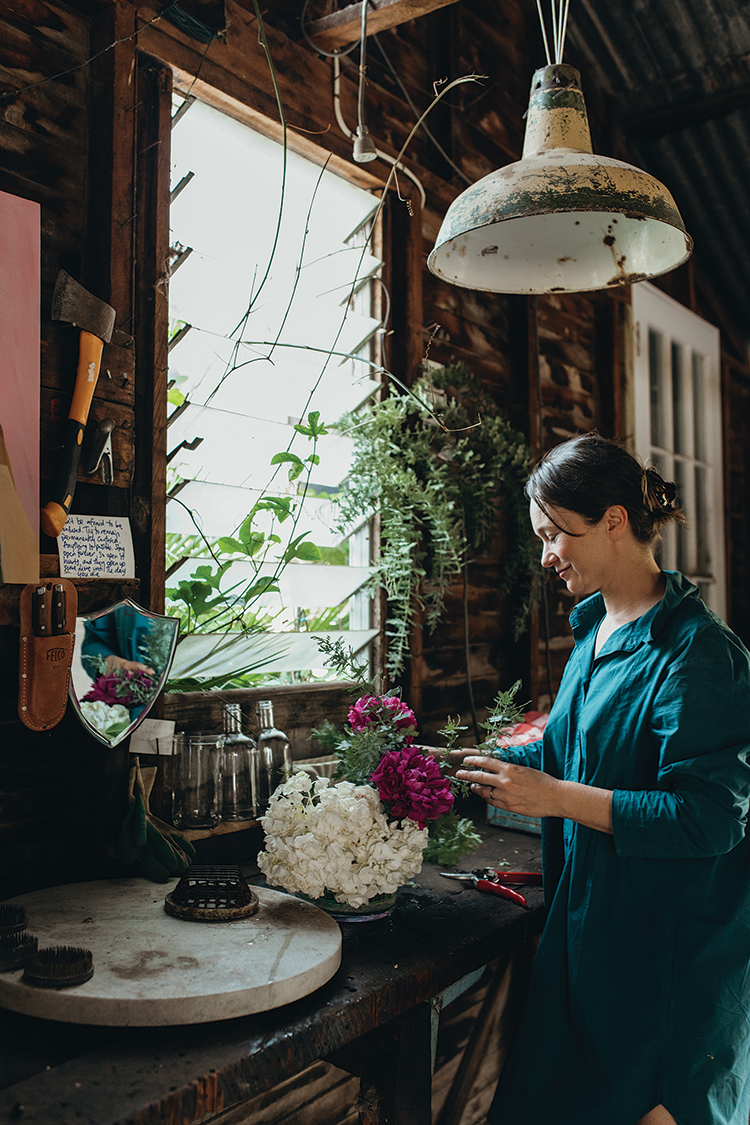
And there were things growing everywhere. Pale green gum leaves, purple poppies and blackberries on the side of the road. Majestic stands of wild fennel. Grand mistletoes hanging off the gum trees like chandeliers.
I started bringing the wild flowers into the house to spruce up the drab rooms, and sprigs of eucalyptus to hang off the shower-head. It was intoxicating. Before too long I never left the house without a pair of secateurs in my glove box. And the long grocery run into town became an opportunity to see what was growing out in the wild.
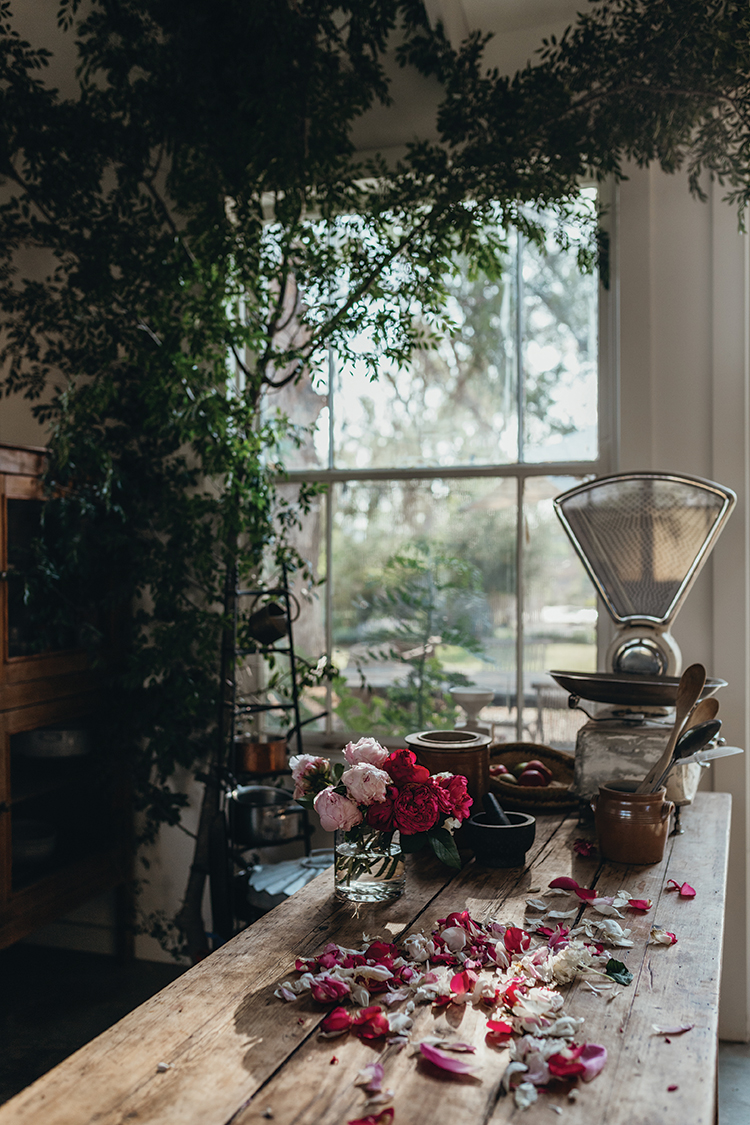
The things that I cut from the side of the road would be the first things I unpacked; before the groceries, before the children. I’d plunge the stems into a bucket of cold water and plonk them in the shade until I got a bit of time to myself later on. Then I could choose the vase, cup or jug and arrange them together in a loose, petal-dropping way. It was very informal, very cheap and therefore easy to continue—and the beauty that resulted gave me such satisfaction to look at.
And then I got into gardening, if you could call chucking a few cosmos seeds into some holes gardening. But you can, because before too long those seeds morphed into towers of pink and white flower heads waving in the wind in front of the kitchen window. It felt very empowering. With very little expense I could dig a hole, plant the seeds and, lo and behold, be surrounded by beauty.
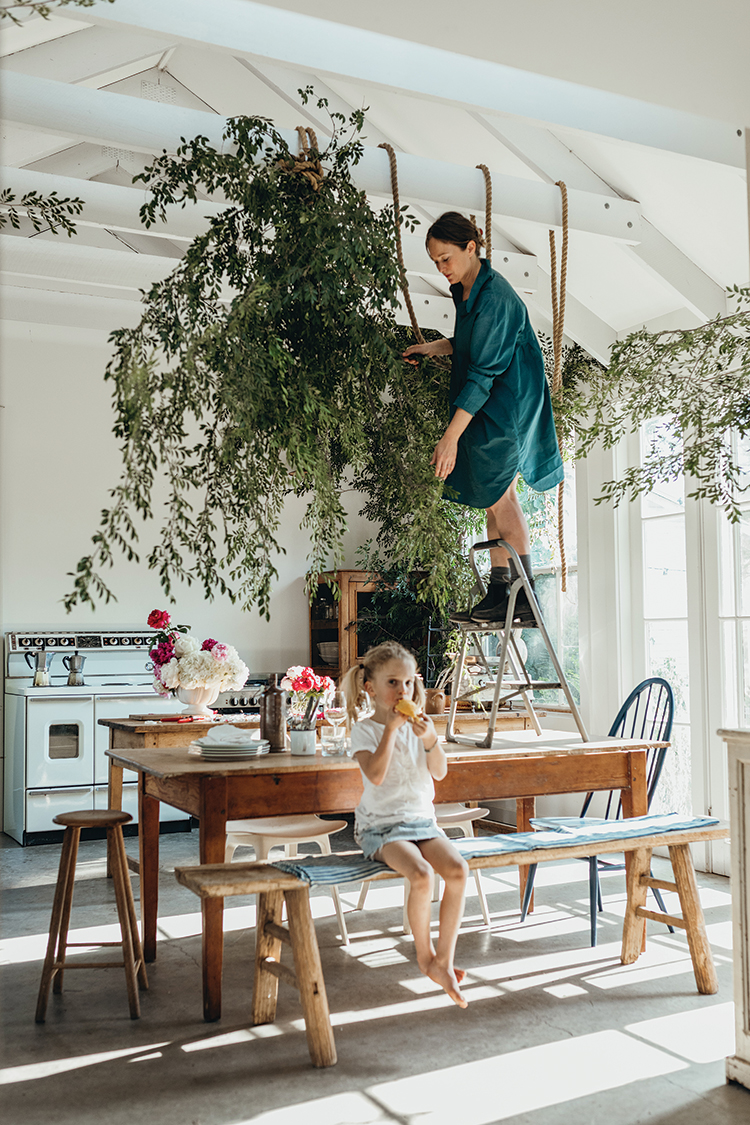
Soon enough my rabbit hutch house was dripping with natural beauty. Luxurious, affordable, compostable splendour. I could use what was growing around me to create, to use author Donna Tartt’s words, “a tableau vivant of the daily.” And without any conscious effort, I began to experience a steady sense of connection to the environment around me. This is why I love flowers. Or more broadly, anything that grows.
At home there is a prickly pear growing in the crook of an enormous gum tree where a branch meets the trunk at least 15 metres up in the air. There is a laneway next to the butcher shop in town where a vigorous clump of nasturtiums happily lives. The butcher lets me pick as many as I want. I then make a nasturtium butter using the leaves and the flowers, and drop him in a rounded, green-flecked butter pat as thanks. He’s never said if he likes it.
A friend who lives in a city terrace grows her annuals in wheelbarrows, which every morning she wheels out onto the verge to harvest the sun. Beyond what we intentionally grow, there is so much out there that just grows, naturally. There is such abundance in the natural world, even now in this awful drought.
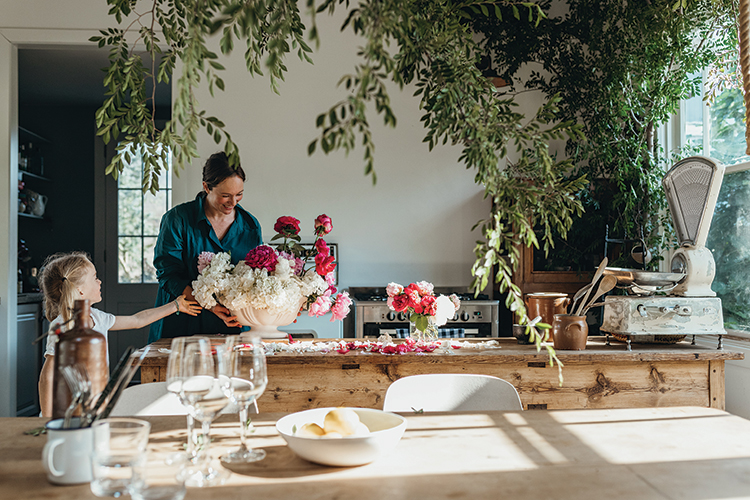
My grandma, Joan Campbell, was a well-known Australian potter. Her studio was in a shed overlooking a little beach in Freemantle and, as well as building huge ceramic wave-like sculptures, she’d also make tiny little people with the bits and bobs she’d find on her walks. These people were just for her. Little girls with seaweed for hair, driftwood limbs, that sort of thing. They were not her most serious art, but I imagine they brought her a lot of joy. Because of them, her walks would have been all about noticing; noticing the little elements on the shore, imagining how they could be transformed into a small person.
It does seem to me that art is, at its core, the art of seeing, the art of mindfulness. The simple act of sitting there and noticing what is in front of you. And I really believe it is good for you, this stopping to look and see. And when you combine it with being in nature, it is completely restorative.
My mother, Susanna, has a great love of plants, and when I was younger she created a large archive of pressed plant specimens from around the suburban streets where we lived. She framed each one and covered the living room walls from floor to ceiling with the plants. Imagine how her walks would have been–also full of noticing.
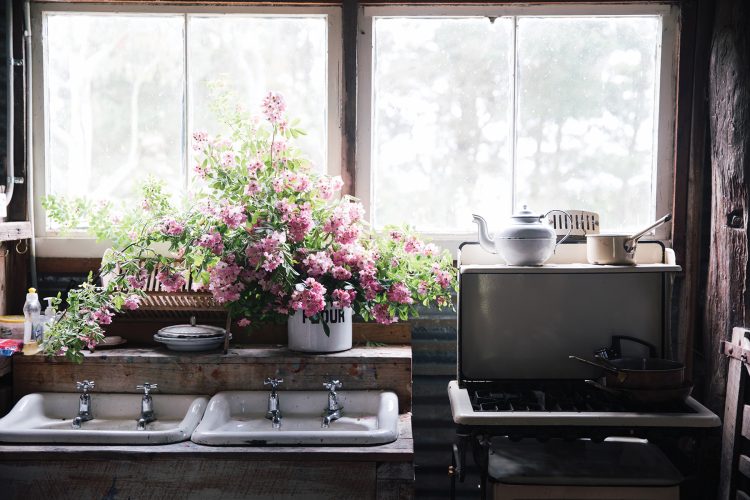
Quite unintentionally, my grandma, my mother and I have all benefited from the joys of noticing what is in the natural world around us, because of the drive to create something. Grandma with her little people, mum with her plant series and me with my roadside weed arrangements. It’s enabled us to apply a kind of filter on the world–which allows you to zoom in on some of the details–the “intensifying effects of a limited view,” as garden writer Mirabel Osler calls it.
Flowers have become a way to cue me into mindfulness.
I certainly didn’t plan it this way, but it has been the most wonderful surprise.I hosted a workshop up in Tenterfield—the closest town to our pecan farm—a couple of weeks ago, which was all about large-scale floral installations. We created one archway arrangement with fresh flowers from the markets, but for another installation we made a huge hanging island with what was growing around drought-stricken Tenterfield. The dried mistletoe hanging from the gums and the brown bracken and other crispy branches from the side of the road were the stars of the show. We created something really beautiful with what might otherwise have been considered depressing.

“We need constant reminding that we have been operators of computers for a single generation and workers in neon-lit offices for three or four,” writes Michael McCarthy in his book The Moth Snowstorm. “But we were farmers for 500 generations, and before that hunter-gatherers for perhaps 50,000 or more, living with the natural world as part of it as we evolved, and the legacy cannot be done away with.”
American social psychologist Ellen Langer defines mindfulness as the simple act of actively noticing things. Instead of meditation or hours of yoga or trips to ashrams, mindfulness can be attained by setting yourself a task to consciously notice things. For example, deciding to notice five new things about your partner over dinner.
“It can be very specific,” Dr. Langer says. “And what will happen is the person will start to come alive for you again. And that facilitates the relationship. When you actively notice new things, that puts you in the present [and] makes you sensitive to context.”
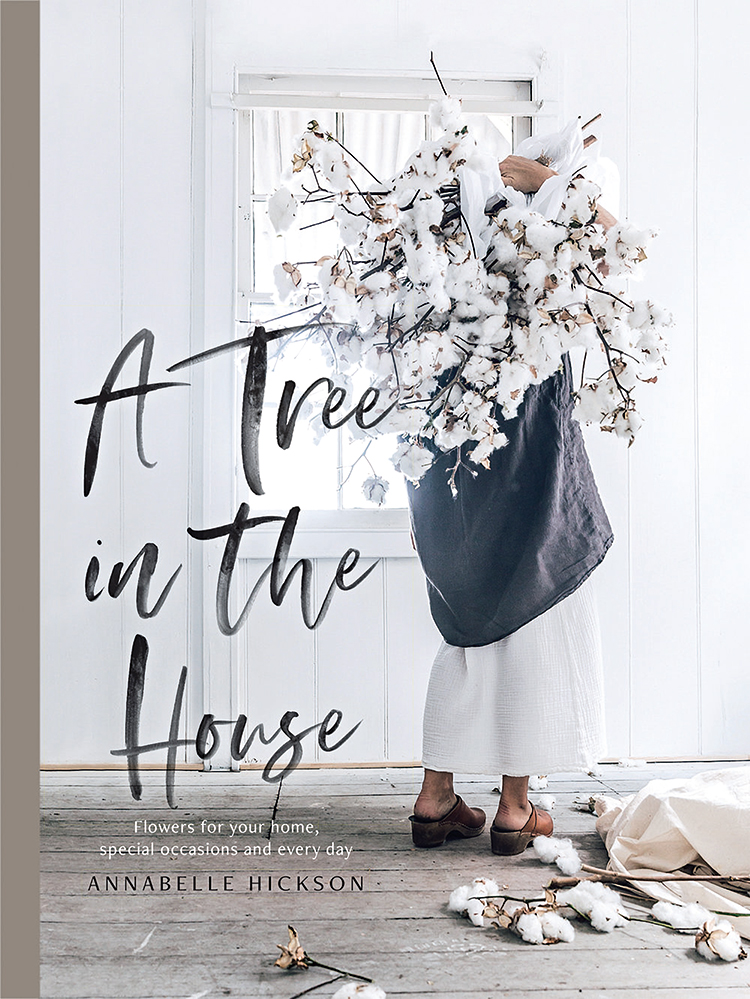
She says that by engaging in an activity—whether it is art, music, sports, gardening, or cooking—on an ongoing basis, we can begin to experience what it is like to be more mindful. Most of the time mindlessness comes by default, not by design, and when we are mindless we’re oblivious to being so. We need to find a way to cue us back into our mindfulness.
For me, flowers have given me a creative purpose, a license to write a book and an excuse to travel the world. All because I let myself follow my own curiosity and steer my own ship, rather than waiting for some job or university course to tell me what I should or could do.
I do love the occasional tendril or delicate branch of foliage dipping below to create an in-the-forest feeling.
One of the lessons learned during my workshop was how to understand and use chicken wire in large installations. Chicken wire is pliable but firm, easy to transport and easy to rig up. There is no right or wrong side. It is strong and, unless observed up close, is more or less invisible. It can hold heavy things overhead. It allows the construction of waves of foliage and firework-bursts of branches. I love it unconditionally. In a situation where you are hanging things from overhead beams, it really is the most wonderful tool.
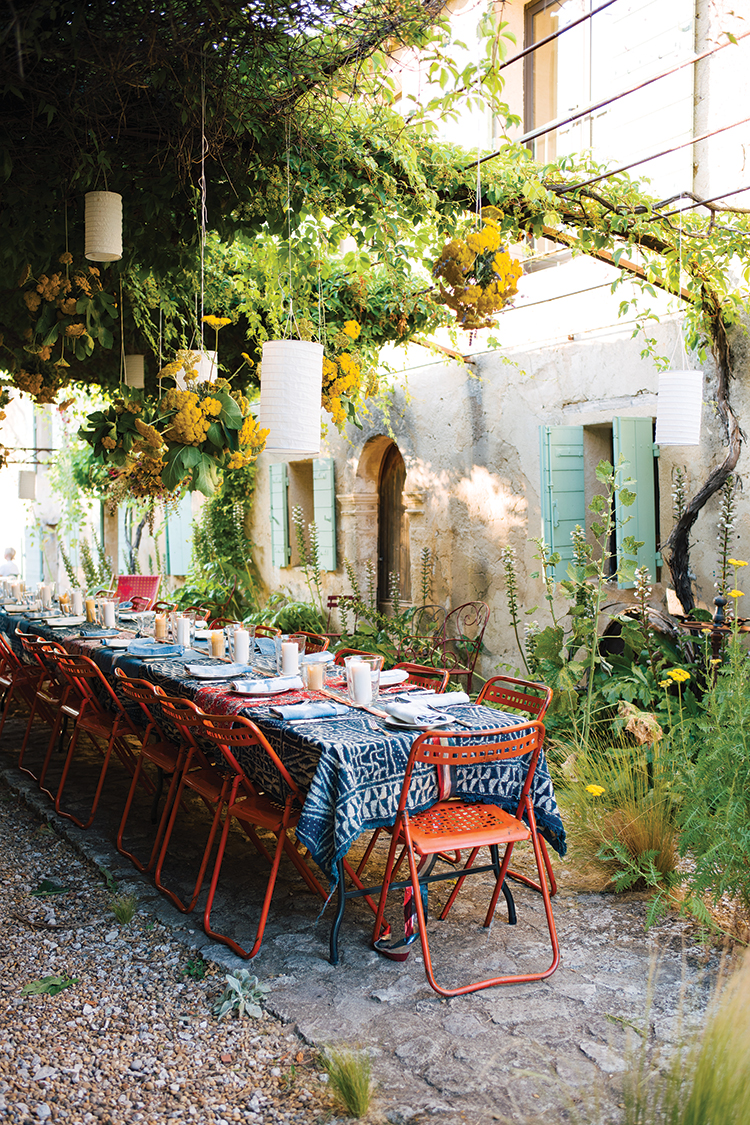
I buy rolls of 50 by 50 mm (2 by 2 in) hexagonal chicken wire—1.2 metres (4 ft) wide at a gauge of 1 or 0.9 mm (.04 in), either 10 or 30 metres (30 or 100 ft) long and cut where necessary. Longer rolls are too heavy to schlepp around and carry up ladders, so don’t be tempted by the cheaper per metre price.
A good rule of thumb is to keep overhead arrangements at least one metre above the table so that seated guests can see each other. Play around with different heights and the different moods that come with each.
You can go down the Loose Leaf path (look them and their Monstera chandeliers up if you don’t know them–their work is astounding), balling up 1 by 1-metre pieces of chicken wire, hanging them from the beams at different heights and depths and then stuffing your foliage into them.
Or you can go down the floating carpet path. Unfurl the chicken wire as if you are rolling out a red carpet, to a length about as high as the beam is off the ground. Rustle up a ladder from which you can comfortably reach the beam. Climb the ladder with a pocket full of zip ties and the end of the unfurled chicken wire in one hand. Don’t try to carry the entire roll up the ladder–leave the weight of it on the ground and just take the unfurled length up with you.
Secure the end of the chicken wire by wrapping it around the beam and zip-tying or wiring it in place in at least four places, weaving the zip ties in and out of several hexagonal cells and around the entire beam.
Then move your ladder to the next beam. Haul up the roll of chicken wire and, leaving a generous swag between the first and second beams, nudge the roll over the top of the second beam and let it fall with a thud to the ground, holding the wire in place on top of the beam.
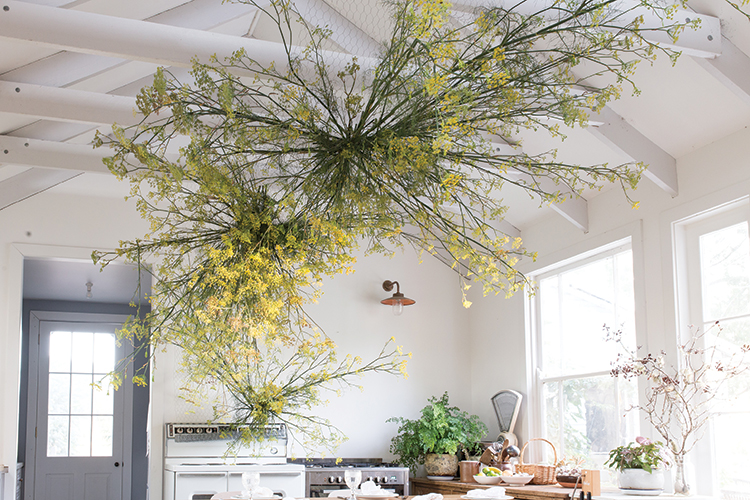
Shift your ladder to the third beam. Haul the chicken roll up and nudge it over, and so on. If the beams are too close together, skip every second beam. When you get to the last beam, adjust the swags of wire. To make them less dippy, pull the wire to make the roll shorter. To make the swags longer, do the opposite. When you are happy with the wave of them, cut the roll, wrap the new end around the last beam and secure it with zip ties in at least four places. Go back to the previous beams and whack in a few zip ties to keep the wave in place.
Now you are ready to insert autumn branches, bursts of tall fennel, gum leaves, cotton–anything that can handle being out of water for a day or two. Weave the stems of the branches over and under the hexagonal cells for extra stability. Thread the branches into central points at different angles and depths, securing them with zip ties where necessary. Angle in some branches from on top of the wave–some can actually rest horizontally on the stretch of chicken wire. Angle things into the wire from underneath the canopy too. If you have any doubts about the branches staying in the wire, secure them with zip ties or wire.
For large rooms, unless you have lots of time and material, it is more effective to create firework explosions at different points along the chicken wire wave than to try to fill every square inch of it.

I’m no more a florist than a home cook is a chef. But the great epiphany of my adult life—which took moving to a remote farm 750 km north west of my hometown of Sydney for me to figure out—is that you can actually do a lot of things that you don’t have official qualifications for. Now I spend most of my time suspending giant branches from ceilings and filling sideboards with undulating rivers of wildflowers, but I quite accidentally stumbled into this creative world.
I was a journalist at the national newspaper—a job I adored wholeheartedly, even the door knocks and the other dreadful things you have to do as a low-rung general reporter. I was looking forward to what I hoped would be a long and successful career in journalism in the big smoke. But then I fell in love with a farmer.
The men in the office called him Biggles because he flew a small plane. He picked me up at the airport for our first date, whizzing us to the beaches of Byron Bay. I remember turning to one of the older reporters for advice just before the date, saying “I think I really like this guy, but I am not sure how he feels about me.” The reporter looked at me and said, “He’s picking you up in a goddamn plane and taking you to Byron Bay. He is keen.” Within about six months I had moved to a farm out west. Can you blame me?

Until I met Ed, I had a track record of being good at working in systems and structures like schools and universities and for other people and companies. I liked to be assigned a project I was qualified to do, to put my head down and to get it done. But the place where I moved with Ed, out in a beautiful valley in the middle of nowhere, had no systems and structures. Or any companies to work for. The closest supermarket was an hour’s drive away. It may as well have been the frontier.
The beautiful arrangements are lovely, but the primary benefit is the way it makes me notice the natural world, the changing of the seasons, the colour of the gum leaves and how they change after rain, the beauty when it’s dry and when it’s green.
I fell into what was a rather uncomfortable slump for several years. I knew I was capable, but could not work out what to do out here. Or rather how to do it without someone assigning deadlines or telling me what needed to be done. I was hopeless on the farm and even worse at doing the farm’s accounting books.

We lived in a charmless little cottage that I could vacuum in its entirety from one power point, but we were ploughing all our money into planting hundreds and hundreds of pecan trees, so other than painting the walls, there was not much I could do on that front.
I realized I had to work out how to be captain of my own ship. I desperately wanted to contribute and create in a way that felt important to me, but I was stuck. And it wasn’t until I started noticing things growing around me that I found a way out of my head.

And there were things growing everywhere. Pale green gum leaves, purple poppies and blackberries on the side of the road. Majestic stands of wild fennel. Grand mistletoes hanging off the gum trees like chandeliers.
I started bringing the wild flowers into the house to spruce up the drab rooms, and sprigs of eucalyptus to hang off the shower-head. It was intoxicating. Before too long I never left the house without a pair of secateurs in my glove box. And the long grocery run into town became an opportunity to see what was growing out in the wild.

The things that I cut from the side of the road would be the first things I unpacked; before the groceries, before the children. I’d plunge the stems into a bucket of cold water and plonk them in the shade until I got a bit of time to myself later on. Then I could choose the vase, cup or jug and arrange them together in a loose, petal-dropping way. It was very informal, very cheap and therefore easy to continue—and the beauty that resulted gave me such satisfaction to look at.
And then I got into gardening, if you could call chucking a few cosmos seeds into some holes gardening. But you can, because before too long those seeds morphed into towers of pink and white flower heads waving in the wind in front of the kitchen window. It felt very empowering. With very little expense I could dig a hole, plant the seeds and, lo and behold, be surrounded by beauty.

Soon enough my rabbit hutch house was dripping with natural beauty. Luxurious, affordable, compostable splendour. I could use what was growing around me to create, to use author Donna Tartt’s words, “a tableau vivant of the daily.” And without any conscious effort, I began to experience a steady sense of connection to the environment around me. This is why I love flowers. Or more broadly, anything that grows.
At home there is a prickly pear growing in the crook of an enormous gum tree where a branch meets the trunk at least 15 metres up in the air. There is a laneway next to the butcher shop in town where a vigorous clump of nasturtiums happily lives. The butcher lets me pick as many as I want. I then make a nasturtium butter using the leaves and the flowers, and drop him in a rounded, green-flecked butter pat as thanks. He’s never said if he likes it.
A friend who lives in a city terrace grows her annuals in wheelbarrows, which every morning she wheels out onto the verge to harvest the sun. Beyond what we intentionally grow, there is so much out there that just grows, naturally. There is such abundance in the natural world, even now in this awful drought.

My grandma, Joan Campbell, was a well-known Australian potter. Her studio was in a shed overlooking a little beach in Freemantle and, as well as building huge ceramic wave-like sculptures, she’d also make tiny little people with the bits and bobs she’d find on her walks. These people were just for her. Little girls with seaweed for hair, driftwood limbs, that sort of thing. They were not her most serious art, but I imagine they brought her a lot of joy. Because of them, her walks would have been all about noticing; noticing the little elements on the shore, imagining how they could be transformed into a small person.
It does seem to me that art is, at its core, the art of seeing, the art of mindfulness. The simple act of sitting there and noticing what is in front of you. And I really believe it is good for you, this stopping to look and see. And when you combine it with being in nature, it is completely restorative.
My mother, Susanna, has a great love of plants, and when I was younger she created a large archive of pressed plant specimens from around the suburban streets where we lived. She framed each one and covered the living room walls from floor to ceiling with the plants. Imagine how her walks would have been–also full of noticing.

Quite unintentionally, my grandma, my mother and I have all benefited from the joys of noticing what is in the natural world around us, because of the drive to create something. Grandma with her little people, mum with her plant series and me with my roadside weed arrangements. It’s enabled us to apply a kind of filter on the world–which allows you to zoom in on some of the details–the “intensifying effects of a limited view,” as garden writer Mirabel Osler calls it.
Flowers have become a way to cue me into mindfulness.
I certainly didn’t plan it this way, but it has been the most wonderful surprise.I hosted a workshop up in Tenterfield—the closest town to our pecan farm—a couple of weeks ago, which was all about large-scale floral installations. We created one archway arrangement with fresh flowers from the markets, but for another installation we made a huge hanging island with what was growing around drought-stricken Tenterfield. The dried mistletoe hanging from the gums and the brown bracken and other crispy branches from the side of the road were the stars of the show. We created something really beautiful with what might otherwise have been considered depressing.

“We need constant reminding that we have been operators of computers for a single generation and workers in neon-lit offices for three or four,” writes Michael McCarthy in his book The Moth Snowstorm. “But we were farmers for 500 generations, and before that hunter-gatherers for perhaps 50,000 or more, living with the natural world as part of it as we evolved, and the legacy cannot be done away with.”
American social psychologist Ellen Langer defines mindfulness as the simple act of actively noticing things. Instead of meditation or hours of yoga or trips to ashrams, mindfulness can be attained by setting yourself a task to consciously notice things. For example, deciding to notice five new things about your partner over dinner.
“It can be very specific,” Dr. Langer says. “And what will happen is the person will start to come alive for you again. And that facilitates the relationship. When you actively notice new things, that puts you in the present [and] makes you sensitive to context.”

She says that by engaging in an activity—whether it is art, music, sports, gardening, or cooking—on an ongoing basis, we can begin to experience what it is like to be more mindful. Most of the time mindlessness comes by default, not by design, and when we are mindless we’re oblivious to being so. We need to find a way to cue us back into our mindfulness.
For me, flowers have given me a creative purpose, a license to write a book and an excuse to travel the world. All because I let myself follow my own curiosity and steer my own ship, rather than waiting for some job or university course to tell me what I should or could do.
I do love the occasional tendril or delicate branch of foliage dipping below to create an in-the-forest feeling.
One of the lessons learned during my workshop was how to understand and use chicken wire in large installations. Chicken wire is pliable but firm, easy to transport and easy to rig up. There is no right or wrong side. It is strong and, unless observed up close, is more or less invisible. It can hold heavy things overhead. It allows the construction of waves of foliage and firework-bursts of branches. I love it unconditionally. In a situation where you are hanging things from overhead beams, it really is the most wonderful tool.

I buy rolls of 50 by 50 mm (2 by 2 in) hexagonal chicken wire—1.2 metres (4 ft) wide at a gauge of 1 or 0.9 mm (.04 in), either 10 or 30 metres (30 or 100 ft) long and cut where necessary. Longer rolls are too heavy to schlepp around and carry up ladders, so don’t be tempted by the cheaper per metre price.
A good rule of thumb is to keep overhead arrangements at least one metre above the table so that seated guests can see each other. Play around with different heights and the different moods that come with each.
You can go down the Loose Leaf path (look them and their Monstera chandeliers up if you don’t know them–their work is astounding), balling up 1 by 1-metre pieces of chicken wire, hanging them from the beams at different heights and depths and then stuffing your foliage into them.
Or you can go down the floating carpet path. Unfurl the chicken wire as if you are rolling out a red carpet, to a length about as high as the beam is off the ground. Rustle up a ladder from which you can comfortably reach the beam. Climb the ladder with a pocket full of zip ties and the end of the unfurled chicken wire in one hand. Don’t try to carry the entire roll up the ladder–leave the weight of it on the ground and just take the unfurled length up with you.
Secure the end of the chicken wire by wrapping it around the beam and zip-tying or wiring it in place in at least four places, weaving the zip ties in and out of several hexagonal cells and around the entire beam.
Then move your ladder to the next beam. Haul up the roll of chicken wire and, leaving a generous swag between the first and second beams, nudge the roll over the top of the second beam and let it fall with a thud to the ground, holding the wire in place on top of the beam.

Shift your ladder to the third beam. Haul the chicken roll up and nudge it over, and so on. If the beams are too close together, skip every second beam. When you get to the last beam, adjust the swags of wire. To make them less dippy, pull the wire to make the roll shorter. To make the swags longer, do the opposite. When you are happy with the wave of them, cut the roll, wrap the new end around the last beam and secure it with zip ties in at least four places. Go back to the previous beams and whack in a few zip ties to keep the wave in place.
Now you are ready to insert autumn branches, bursts of tall fennel, gum leaves, cotton–anything that can handle being out of water for a day or two. Weave the stems of the branches over and under the hexagonal cells for extra stability. Thread the branches into central points at different angles and depths, securing them with zip ties where necessary. Angle in some branches from on top of the wave–some can actually rest horizontally on the stretch of chicken wire. Angle things into the wire from underneath the canopy too. If you have any doubts about the branches staying in the wire, secure them with zip ties or wire.
For large rooms, unless you have lots of time and material, it is more effective to create firework explosions at different points along the chicken wire wave than to try to fill every square inch of it.



















